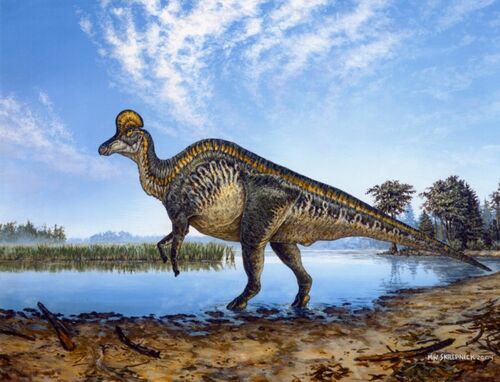I've got more dino heads for you guys to look at!

First is Ouranosaurus (Monitor Lizard) (Taquet, 1976). As you can see, there is no flamboyant crest or horns, but there is a bump between the eyes. It has a flattened beak, however it is not a duckbill, being closer to more basal hadrosauriformes like Iguanodon (Mantell, 1825). Ouranosaurus possessed cheek pouches which it used to hold food while chewing, similar to modern-day hamsters. The skull measured 55cm from the tip of the snout to the back of the skull.


Next is Corythosaurus (Helmeted Lizard) (Brown, 1914). Unlike Ouranosaurus, Corythosaurus is a hadrosaur or duck-billed dinosaur. The crest on its head was probably used as a mating display. It was also hollow so it probably made loud noises with it as well to communicate over long distances. The skull was 55cm from the tip of the snout to the back of the head.


Thirdly, we have another hadrosaur, Parasaurolophus (Near Saurolophus) (Parks, 1922). The most obvious feature of this dinosaur's skull is the long, hollow crest that was probably used to make sounds. Like Ouranosaurus, Parasaurolophus had large cheek pouches for holding food whilst chewing. The skull measured 1.25 m from the tip of the snout to the end of the crest.


Finally, for a change of pace, we have the ceratopsian Triceratops (Three-Horned Face) (Marsh, 1889). As is very clear, Triceratops had one horn on its nose and two above its eyes, probably used for display rather than defence. The beak was parrot-like and was used to slice up tough vegetation. The neck frill was surrounded by knobs of bone, the frill was probably brightly coloured. The skull was 1.8m from the tip of the snout to the back of the frill.
So, four more dinosaurs, four different skulls. Next time, we will look at what happens to fossils when they get back to the lab.
References
Brown, B. (1914) 'Corythosaurus casuarius, a new crested dinosaur from the Belly River Cretaceous: With Provisional classification of the family Trachodontidae', Bulletin of the American Museum of Natural History, 33 (35)
Brown, B. (1914) 'Corythosaurus casuarius, a new crested dinosaur from the Belly River Cretaceous: With Provisional classification of the family Trachodontidae', Bulletin of the American Museum of Natural History, 33 (35)
Mantell, G. (1825) 'Notice on the Iguanodon, a newly discovered fossil reptile, from the sandstone of Tilgate forest, in Sussex', Philosophical Transactions of the Royal Society, 115, pp. 179-186
Marsh, O. (1889) 'Notice of gigantic horned Dinosauria from the Cretaceous', American Journal of Science, 38, pp. 173-175
Parks, W. (1922) 'Parasaurolophus walkeri, a new genus and species of crested trachodont dinosaur', University of Toronto Studies, Geology Series, 13, pp. 1-32
Taquet, P. (1976) Geologie et paleontologie du gisement de Gadoufaoua (Aptien du Niger), Paris: C.N.R.S.
No comments:
Post a Comment